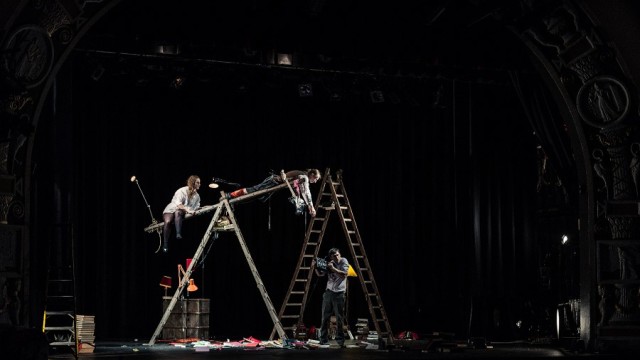The Corn Exchange, Brighton; 30th March 2016

Circus and books are two of my favourite things, so the chance to see them combined in the new production from Bikes & Rabbits, touring under the CryingOutLoud production banner, was too good to miss. It has been devised by the performing company of Alice Allart, Fabrice Dominici and Patrice Colet, with direction from Yann Ecauvre of Cirque Inextremiste, and while it contains some memorable images and an engaging sound presence, it unfortunately lacks dramaturgical clarity.
The stage is set with clouds of dust, anglepoise lamps with paper shades, and stacks and stacks of books whose makeshift shelves are formed from age-worn wooden step-ladders. A bright orange electric cable curled across the stage seems out of place, and is one of several decisions that do not seem fully considered in respect of the world being created.
Dominici is the bookshop owner (ok, in the programme it says librarian, but I recognise the traits of a quirky independent bookstore more than I do any formal library), who finds his day disrupted by a pair of surprise visitors from the realms of magic realism. Allart, who founded Bikes & Rabbits in 2012, is strongly influenced by cinema and literature according to her programme bio, and often it feels that the scale of action in These Books… is more appropriate to one of these more focussed media than to the expanse of an open stage. Her character sits atop a ladder, creating birds, costumes – and, at one point, a gun – out of the pages of her books. At least, that’s what I assume to be happening. I can’t really see any of the detail from the 8th row of the audience. Colet is a kilted guitar-player, who also climbs to the top of the rickety ladder shelving and provides sonic background that varies from fairytale-melodic to loudly abrasive twanging and reverb, separate to the physical rhythms of Dominici’s action down below.

It’s difficult to follow what to watch, with Allart and Colet apparently amusing themselves atop a horizontally balanced ladder for most of the piece, oblivious to us and Dominici, while the bookseller himself tries to find ways to remove them, including recruiting members of the audience on two occasions. Opportunities for the live sound to feed the understated clowning haven’t been taken.
The construction of ladders is where the circus skills of the performers are most utilised, but the delicate balance needed to manipulate the structure is hidden from the audience and made to look as if there is no work taking place. In fact, the whole show lacks drama or tension, in what is more a performed score of movements than a story for us to care about or engage with. We pick up that Dominici is trying to get rid of the intruders, attempting to cut them down from their perch, but there doesn’t seem to be anything at stake, and there isn’t a clear through line of intention, even with clown-logic.

The audience participation sections are well handled, and Dominici communicates strongly and concisely through mime, facial expression, and a jubilantly whispered ‘yessss’ or two. The unpredictable reactions get some good laughs, and I can imagine Dominici would put on a great street show. Colet is engrossed in his instrument and electronic control box, which also manage to ascend to the top of the ladders. Allart dreamily treats everything she encounters as a new toy to experiment with.
Like too many new circus-theatre pieces, this work feels as though it has evolved directly from an initial experimentation with particular objects rather than from any clear intention of what the audience experience should be. There are some delightful ideas that I would like to see developed more, but the ponderous plodding pace of Dominici’s existence, marked out from the beginning by a low, slow, guitar pulse and never altering, is too dull for me.

By the time the ladders are reassembled into a slackline rig for Allart to perform some carefully controlled slow balances as another example of her whimsical intrusion into Dominici’s life, it comes across as ‘more of the same’ rather than a standout feat.
The show ends on an amusing gag, but has no resolution to its story. Invigorating lighting design from Christopher McGhee is the most characterful element of These Books… and, aesthetically appealing though this show may be, it provides little mental stimulation. Its initial charm wears thin through lack of development.



